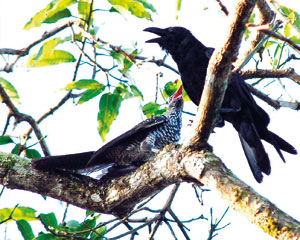Very soon it will be time for the Sinhala and Tamil New Year, a cultural event celebrated through the ages.
The annual inter-monsoonal rains occurring in March / April trigger off natural instincts within the fauna to breed, for flowers to bloom and fruits to ripen. Thus the arrival of the Sinhala and Tamil New Year is symbolic with the Asian Koel (Eudynamys scolopacea / Sinhala-Koha / Tamil-Kuil) and the blooming of Erabadu (Erythrina indica). The Koel plays the first fiddle in the dawn chorus that we start hearing every day by 4.30 a.m.
The otherwise quiet Asian Koel turns out to be very vociferous during this time looking for a suitable mate. These high decibel calls to a mate indicate the arrival of the New Year. Many are under the impression that the Koel has made its annual migration. The Asian Koel is not a migrant to the country but a breeding resident. What is unique is its breeding habits.
Almost all Koels and the Cuckoos are brood parasites. They lay eggs in a host nest and the host brings up the fledglings. For this they have to be on time with the breeding pattern of the host. The Asian Koel in Sri Lanka prefers the House Crow or the Jungle Crow as the host. The act of laying the egg in the host nest is done very stealthy.
The male Koel approaches the shabby nest of the crow in the pretext of snatching an egg from the clutch. This encourages the crow to attack and pursue him, which leaves the nest unattended and ready for the female to deposit her egg. In this process she may remove a host egg which has no relation to numbers or counting but purely through instinct.
A female will not stop at one host nest but would lay in several host nests. Her egg is larger than the host egg and will hatch in 12 to 14 days, about three days before the host’s. The chick is featherless when hatched and is said to have a very sensitive skin patch on its back.
Anything that touches this patch irritates the chick and to avoid this, it pushes out the host eggs and other chicks. This leaves the parasitic chick with all the food resources. Hence it grows up fast, in 20 to 28 days.
By this time the chicks are quite large and very different to the foster parents in appearance but still depend on them for food. They now start mimicking the call of the juvenile crow, and begging for food from the foster parents.
This process continues for almost a month at times. The high decibel call of the Asian Koel is significant with culture and prediction throughout the South and South East Asian region going down to East Australia which is home to the Australian Koel, the Rain Bird whose call coincides with the oncoming wet weather.
By the end of May you will not hear the Koel unless you are an early riser with good auditory senses.
(The writer is a Member of the Field Ornithology Group of Sri
Lanka) |


